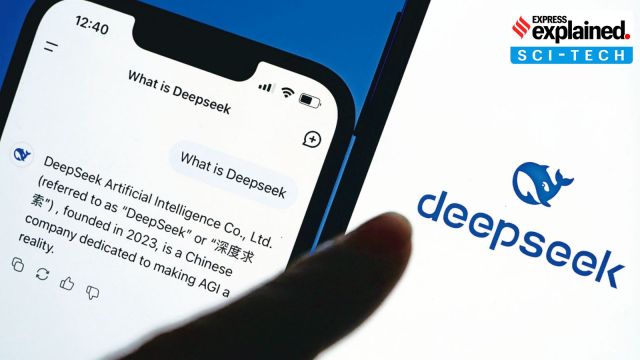DeepSeek’s Sputnik moment: 5 ways in which US-China AI race plays out for India
One is the strategic salience of the moment. Historical comparisons are odious, but in terms of the sheer shock it produced, DeepSeek reminds us of the Soviet Union’s launch of Sputnik, the Earth’s first artificial satellite in October 1957.
 Monday’s bloodbath on Wall Street of AI stocks dramatises the surprise that shattered Silicon Valley’s claims of a big American lead over China on AI. Looking beyond the shorting of US AI stocks, DeepSeek marks just the beginning, rather than the end of the AI race.
Monday’s bloodbath on Wall Street of AI stocks dramatises the surprise that shattered Silicon Valley’s claims of a big American lead over China on AI. Looking beyond the shorting of US AI stocks, DeepSeek marks just the beginning, rather than the end of the AI race. As Prime Minister Narendra Modi travels to Paris to co-chair the AI summit convened early next month by French President Emmanuel Macron, and may also go to Washington — if plans to meet President Donald Trump work out — the Indian establishment has to get its sums right in assessing the implications of the AI race between US and China, shaken up by the release of Chinese AI assistant DeepSeek R1 over the weekend.
Five of them stand out.
 One is the strategic salience of the moment. Historical comparisons are odious, but in terms of the sheer shock it produced, DeepSeek reminds us of the Soviet Union’s launch of Sputnik, the Earth’s first artificial satellite in October 1957. The stunning demonstration of Soviet Russia’s capabilities in frontier technology set off panic within the smug American establishment that was so confident of its dominance in science and technology. It also spurred Washington into a massive space programme ofits own, including the landing of the first human on the Moon.
One is the strategic salience of the moment. Historical comparisons are odious, but in terms of the sheer shock it produced, DeepSeek reminds us of the Soviet Union’s launch of Sputnik, the Earth’s first artificial satellite in October 1957. The stunning demonstration of Soviet Russia’s capabilities in frontier technology set off panic within the smug American establishment that was so confident of its dominance in science and technology. It also spurred Washington into a massive space programme ofits own, including the landing of the first human on the Moon.
Monday’s bloodbath on Wall Street of AI stocks dramatises the surprise that shattered Silicon Valley’s Second is the intensification of the geopolitical rivalry between the US and China. If Sputnik ratcheted up the Cold War that had begun a decade earlier between America and the Soviet Union, DeepSeek heralds an escalation of the geopolitical rivalry between the US and China that has been unfolding for nearly a decade. Much like the Sputnik in the 1950s, DeepSeek brings a new technological frontier into the great power competition.
But the Sputnik moment did not tell us how the tech race would play out in subsequent decades. Moscow offered vigorous competition to Washington during the Cold War, but could not sustain its technological parity after the collapse of the Soviet Union. China is a different kind of power, with a large GDP and massive investments in frontier technologies. Yet there is no telling how its rivalry with America will unfold in the coming years. For now, though, it is reasonable to assume that the US and China are way ahead of other major powers and poised to make the AI race a bipolar one.
Third, DeepSeek is a reminder that money buys many things, but it is not everything; certainly not love or the capacity for innovation. If the US is seen as pouring billions of dollars into building more computing power and better AI models, DeepSeek has shown it is possible to do more with less.
That should give hope for India and other middle powers like France. The gap between the US and China is much less than that between the two of them and the rest. While the middle powers can’t keep pace with the US and China, they could do enough to stay in the AI game.
Both India and France (Europe) talk about “Sovereign AI”. They will need strategies that will emphasise both cooperation with the US and independent development of AI. Although the AI world might never be truly multipolar, there would be considerable room for other players capable of research, development, and innovation.
Fourth, that room would be much larger if the US chooses the partnership model with allies to compete with China, instead of going it alone. The Biden Administration was open to partnership with India, but concerns about leakage of technology from India to Russia had put a dampener on the kind of access the US is willing to offer India on AI chips. For Delhi, the time is now to decide on how much weight it is willing to give Russia in advancing its interests with the US on the AI game.
Finally, Sputnik is an important reminder that great powers will also embark on cooperation in advanced technologies. Although Sputnik’s launch in 1957 set off an arms race, outer space eventually provided a venue to cooperate and demonstrate their shared commitment to humanity’s technological advancement and global peace. The detente years (the 1970s) saw Moscow and Washington begin cooperation in outer space that endures to the day.
There are many in the US and China who think the two sides should cooperate on AI for the benefit of the world, much in the manner America and Russia did in outer space. It is indeed possible: AI cooperation could be on the table when Washington and Beijing begin a substantive engagement. The Biden years have seen the US and China start a dialogue on AI to prevent its misuse and potential destabilisaton of nuclear deterrence in the AI age.
As the military applications of AI begin to proliferate, it is not difficult to imagine US-China cooperation in the creation of a set of rules to control the spread of AI, much in the manner that the US and Russia developed a nuclear control regime in the 1960s and 1970s.
India found itself on the wrong side of these nuclear lines, thanks to Delhi’s ideological confusion on atomic issues, policy incoherence, and geopolitical sentimentalism. It took nearly four decades to undo that nuclear blunder. Hopefully, Delhi is smarter today and can define its strategic interests in the AI domain clearly and ensure that India will be part of shaping the global governance of AI rather than a mere subject of it.
(The writer is Contributing Editor on international affairs for The Indian Express)





- 01
- 02
- 03
- 04
- 05

































